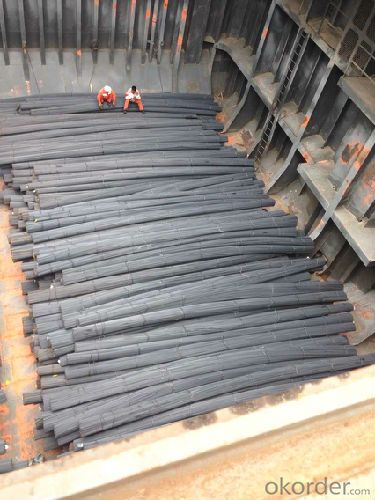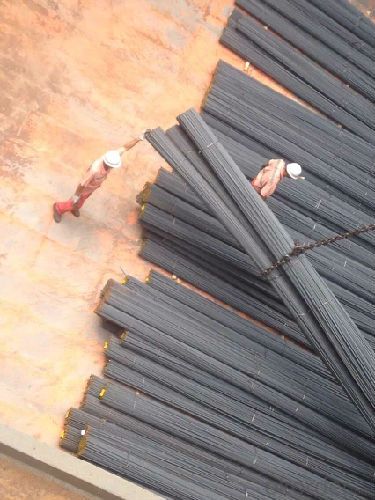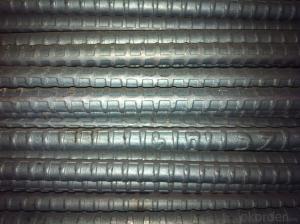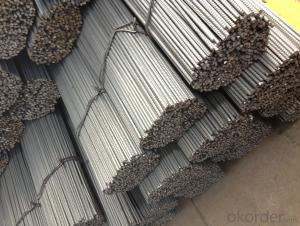Deformed Steel Bar, 10mm 12mm Steel Rebar
- Loading Port:
- China main port
- Payment Terms:
- TT or LC
- Min Order Qty:
- 100 m.t.
- Supply Capability:
- 100000 m.t./month
OKorder Service Pledge
OKorder Financial Service
You Might Also Like
Product Description:
OKorder is offering Deformed Steel Bar, 10mm 12mm Steel Rebar at great prices with worldwide shipping. Our supplier is a world-class manufacturer of steel, with our products utilized the world over. OKorder annually supplies products to African, South American and Asian markets. We provide quotations within 24 hours of receiving an inquiry and guarantee competitive prices.
Product Applications:
Deformed Steel Bar, 10mm 12mm Steel Rebar are ideal for structural applications and are widely used in the construction of buildings and bridges, and the manufacturing, petrochemical, and transportation industries.
Product Advantages:
OKorder's Deformed Steel Bar, 10mm 12mm Steel Rebar are durable, strong, and wide variety of sizes.
Main Product Features:
· Premium quality
· Prompt delivery & seaworthy packing (30 days after receiving deposit)
· Can be recycled and reused
· Mill test certification
· Professional Service
· Competitive pricing
Product Specifications:
Manufacture: Hot rolled
Grade: HRB335,HRB400,HRB500
Certificates: ISO, SGS, BV, CIQ
Length: 6m – 12m, as per customer request
Packaging: Export packing, nude packing, bundled
Deformed Steel Bar | ||
Diameter (MM) | Cross Sectional Area (MM2) | Theorectical Weight (KG/M) |
6 | 28.27 | 0.222 |
8 | 50.27 | 0.395 |
10 | 78.54 | 0.617 |
12 | 113.1 | 0.888 |
14 | 153.9 | 1.21 |
16 | 201.1 | 1.58 |
18 | 254.5 | 2 |
20 | 314.2 | 2.47 |
22 | 380.1 | 2.98 |
25 | 490.9 | 3.85 |
28 | 615.8 | 4.83 |
32 | 804.2 | 6.31 |
36 | 1018 | 7.99 |
40 | 1257 | 9.87 |
Grade | Technical data of the original chemical composition (%) | |||||||
C | Mn | Si | S | P | V | |||
HRB500 | ≤0.25 | ≤1.60 | ≤0.80 | ≤0.045 | ≤0.045 | 0.04-0.12 | ||
Physics capability | ||||||||
Yield Strength(N/cm2) | Tensile Strength(N/cm2) | Elongation (%)
| ||||||
≥500 | ≥630 | ≥12 | ||||||
FAQ:
Q1: Why buy Materials & Equipment from OKorder.com?
A1: All products offered byOKorder.com are carefully selected from China's most reliable manufacturing enterprises. Through its ISO certifications, OKorder.com adheres to the highest standards and a commitment to supply chain safety and customer satisfaction.
Q2: How many tons of steel products could be loaded in containers?
A2: Usually the steel products are delivered by bulk vessel because of the large quantity and the freight. However, there are no bulk vessel enter some seaports so that we have to deliver the cargo by containers. The 6m steel product can be loaded in 20FT container, but the quantity is changed according to the size, usually from 18tons to 25tons.
Q3: How soon can we receive the product after purchase?
A3: Within three days of placing an order, we will arrange production. The normal sizes with the normal grade can be produced within one month. The specific shipping date is dependent upon international and government factors, the delivery to international main port about 45-60days.
Images:


- Q:Are there any health and safety concerns related to steel rebars?
- Yes, there are potential health and safety concerns related to steel rebars. Handling and working with steel rebars can pose risks such as cuts, injuries from falling or displaced rebars, and musculoskeletal disorders due to heavy lifting or repetitive movements. Additionally, workers may be exposed to hazards during the fabrication process, such as welding fumes or noise pollution. Adequate safety measures, including personal protective equipment and proper training, should be implemented to mitigate these risks and ensure a safe working environment.
- Q:Can steel rebars be used in pedestrian bridge construction?
- Yes, steel rebars can be used in pedestrian bridge construction. Steel rebars are commonly used as reinforcement in concrete structures, including bridges. They enhance the structural integrity and strength of the bridge, ensuring its ability to withstand various loads and forces. Steel rebars provide the necessary reinforcement to resist tension, bending, and shear forces, making them an ideal choice for pedestrian bridge construction. Additionally, steel rebars have excellent durability, corrosion resistance, and are readily available, making them a cost-effective and reliable option for bridge construction.
- Q:Cast-in-place with 10 mm reinforcement, a good layer or 8 mm double layer? Why?
- If the reinforcement ratio of the situation, the use of 8 mm double reinforced than a layer of 10 mm steel is better, while using the double reinforced cast-in-place floor to prevent from the temperature shrinkage stress is good Oh, can actually try to use reinforced reinforcement ratio is moderate Oh, the only way to ensure the floor the panel does not appear the phenomenon of cracking, especially the roof panel, reinforcement ratio is very important.
- Q:What is the effect of exposure to chemicals on steel rebars?
- Exposure to chemicals can have various effects on steel rebars depending on the specific chemical involved. Corrosive chemicals, such as acids or salts, can cause corrosion and weaken the steel rebars over time. This can compromise the structural integrity of reinforced concrete structures, leading to potential safety hazards. On the other hand, some chemicals like epoxy or protective coatings can be applied to steel rebars to enhance their resistance to corrosion and extend their lifespan. Overall, the effect of exposure to chemicals on steel rebars can range from degradation to protection, highlighting the importance of proper material selection and maintenance in construction projects.
- Q:How do steel rebars affect the overall crack resistance of concrete structures?
- Steel rebars significantly improve the crack resistance of concrete structures. By reinforcing the concrete, rebars help distribute and absorb tensile forces, preventing the formation and propagation of cracks. This reinforcement enhances the overall strength and durability of the concrete, making the structure more resistant to cracking under various loads and environmental conditions.
- Q:How are steel rebars connected or joined together during construction?
- Steel rebars are typically connected or joined together during construction using a variety of methods and techniques. The most common method is by overlapping the rebars and tying them together using steel wire. This process is known as rebar tying or wire tying. To ensure a strong and secure connection, the rebars are overlapped at a certain length, typically between 40 to 60 times the diameter of the rebars. The overlapping length allows for the transfer of load and ensures structural integrity. Once the rebars are properly overlapped, steel wire is tightly wrapped around the intersection point to hold them together. Another method of connecting rebars is by using mechanical couplers. Mechanical couplers are pre-fabricated devices that are used to join two rebars together. These couplers provide a threaded connection, allowing for a more precise and efficient joining process. The rebars are inserted into the couplers, and then the couplers are tightened using a wrench or other appropriate tool. Welding is also used to connect rebars, especially in larger construction projects. Welding involves melting the rebars at the intersection point and fusing them together using heat and pressure. This method provides a strong and permanent connection, but it requires skilled labor and proper safety precautions to ensure the quality of the weld. Furthermore, in some cases, rebars can be connected using epoxy bonding. Epoxy bonding involves applying an adhesive material to the surface of the rebars and then pressing them together. The epoxy acts as a bonding agent, creating a strong and durable connection between the rebars. The method of connecting rebars during construction depends on various factors such as the size of the rebars, the specific requirements of the project, and the construction techniques being used. It is essential to follow industry standards and guidelines to ensure the proper connection and integrity of the rebars, as they play a critical role in reinforcing concrete structures.
- Q:Are steel rebars suitable for use in high-temperature applications?
- Yes, steel rebars are generally suitable for use in high-temperature applications. Steel has excellent heat resistance properties and can withstand high temperatures without significant structural degradation. However, it is important to consider the specific requirements of the application and consult with experts to ensure the appropriate type of steel rebar is selected to meet the desired temperature resistance.
- Q:What is the role of steel rebars in reducing concrete creep?
- Concrete creep, the gradual deformation of concrete over time under sustained loading, is significantly reduced by the incorporation of steel rebars. These high-strength reinforcement bars enhance the structural integrity and durability of concrete structures by providing tensile strength to counteract the forces that cause creep. Under sustained loads, concrete experiences internal stresses that can lead to creep. However, the presence of steel rebars helps distribute these stresses more evenly throughout the structure, acting as reinforcement to absorb and redistribute the tensile forces and minimize concrete deformation. Additionally, steel rebars improve the bond between concrete and reinforcement, ensuring they work together as a composite material. This bond prevents the formation of cracks, which can contribute to creep. Moreover, steel rebars enhance the overall stiffness and rigidity of concrete structures, resisting the deformation caused by creep and maintaining stability over time. In conclusion, steel rebars play a crucial role in reducing concrete creep by providing tensile strength, distributing internal stresses, improving the bond between concrete and reinforcement, and enhancing overall stiffness. Engineers can effectively mitigate the effects of creep and ensure long-term performance and durability by incorporating steel rebars into concrete structures.
- Q:What is the process of anchoring steel rebars in concrete?
- The process of anchoring steel rebars in concrete involves several steps. First, the rebars are cut to the required length and bent as per the structural design. Next, the concrete formwork is prepared, ensuring it is clean and free from any debris. Once the formwork is ready, the rebars are carefully placed and positioned within the formwork according to the specified spacing and alignment. They are usually supported by chairs or spacers to maintain the desired position. After the rebars are properly positioned, the formwork is secured, and concrete is poured, ensuring it completely surrounds and covers the rebars. The concrete is then allowed to cure and harden, providing a strong bond between the steel rebars and the concrete. Ultimately, the process of anchoring steel rebars in concrete involves proper planning, positioning, and securing of the rebars within the formwork, followed by pouring and curing of the concrete to create a robust and durable structure.
- Q:What is the role of steel rebars in basement wall construction?
- The role of steel rebars in basement wall construction is to provide reinforcement and structural support to the concrete wall. Steel rebars, also known as reinforcing bars, are typically made of carbon steel and are placed in the concrete before it is poured. The rebars are strategically positioned within the concrete to add strength and stability to the wall. They help to distribute the load and forces that the wall may encounter, such as soil pressure or lateral forces from the surrounding environment. This reinforcement prevents the wall from cracking or collapsing under these external pressures, ensuring its durability and structural integrity. In addition to reinforcing the basement wall, steel rebars also help to control shrinkage and expansion of the concrete due to temperature changes. By providing a framework within the wall, the rebars help to limit the formation of cracks and maintain the overall stability of the structure. Overall, the presence of steel rebars in basement wall construction significantly enhances the strength and durability of the concrete wall. They play a crucial role in ensuring the integrity of the structure and protecting it from potential damage or failure.
1. Manufacturer Overview |
|
|---|---|
| Location | |
| Year Established | |
| Annual Output Value | |
| Main Markets | |
| Company Certifications | |
2. Manufacturer Certificates |
|
|---|---|
| a) Certification Name | |
| Range | |
| Reference | |
| Validity Period | |
3. Manufacturer Capability |
|
|---|---|
| a)Trade Capacity | |
| Nearest Port | |
| Export Percentage | |
| No.of Employees in Trade Department | |
| Language Spoken: | |
| b)Factory Information | |
| Factory Size: | |
| No. of Production Lines | |
| Contract Manufacturing | |
| Product Price Range | |
Send your message to us
Deformed Steel Bar, 10mm 12mm Steel Rebar
- Loading Port:
- China main port
- Payment Terms:
- TT or LC
- Min Order Qty:
- 100 m.t.
- Supply Capability:
- 100000 m.t./month
OKorder Service Pledge
OKorder Financial Service
Similar products
New products
Hot products
Hot Searches
Related keywords




























